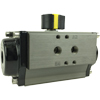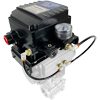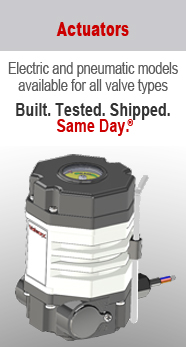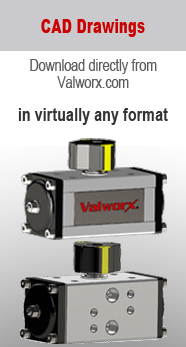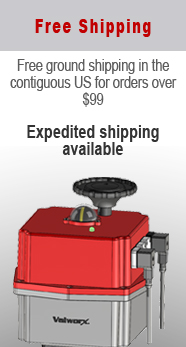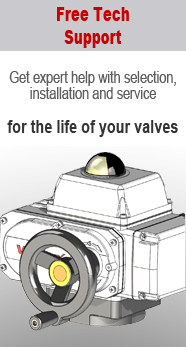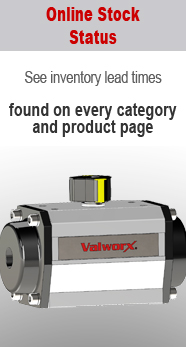Air Actuators & Accessories
Learn About Air Actuators & Accessories
Air actuators are used to automatically operate quarter turn ball and butterfly valves. Actuation is achieved by compressed air pushing against a pair of opposing pistons. Air actuators, also known as pneumatic actuators, are simple, reliable, and rugged. Product lifetime of over one million cycles is not uncommon.
Air actuators can be double acting, which uses compressed air to open and close, or spring return, which uses compressed air to open and springs to return the valve closed (or vice versa).
Because of their simplicity and durability, air actuation has been the solution of choice for millions of applications worldwide. One potential drawback, however, is that they require a source of compressed air. This is typically not an issue in plant environments where factory compressed air is normally available, but for remote field applications a long run of high pressure pipe is impractical. In this case, electric actuators should be used instead.
Pneumatic actuators consist of an actuator housing and a pair of horizontally opposed pistons connected to either a Rack & Pinion or Scotch Yoke mechanism. These linkages translate the linear motion of the pistons to rotary motion of the output drive. Click the following link for a detailed overview of Scotch Yoke and Rack & Pinion air actuators.


For spring return models, springs are added between the piston and housing end caps. When the pistons expand outward on the power stroke the pistons are compressed, and when the compressed air is vented the springs return the actuator to its starting position.
Valworx quarter turn pneumatic actuators use a standard ISO5211 mount pad to connect to the valve. The ISO5211 standard specifies the stem size, bolt size and bolt radius. This widely accepted standard allows valves and actuators to be mounted regardless of manufacturer. Some manufacturers also have brand-specific mounting patterns. All Valworx valves and actuators utilize the ISO5211 mounting standard.

Air actuators are passive devices, meaning they only act when receiving compressed air (or a spring to passively close). Controlling the actuator therefore involves controlling the supply of compressed air. This is typically accomplished in two ways.
First, a remote pilot valve can be plumbed to the actuator. Upon receipt of a signal the pilot valve feeds compressed air to the actuator. Remote pilot control is usually done when several valves are in close proximity and the actuators are controlled by a valve bank consisting of several separately-mounted pilot valves.
Second, a pilot solenoid valve can be mounted directly to the actuator. A compressed air line is threaded to the input port of the solenoid valve. An electric current energizes the solenoid which moves a plunger, and the plunger opens or closes specific ports on the actuator providing compressed air to actuate the valve in the desired rotation.

These type of pilot solenoid valve are commonly called direct mount for obvious reasons. They eliminate the need for a valve bank and are typically used where only a few valves are required.
All Valworx air actuators have a standard interface that accepts direct mount solenoid valves, and we sell pilot solenoid valves in several voltages as options.
Air actuators offer several advantages vs other technologies. Cycle time is typically very quick (<1 sec) and they can essentially operate on a continuous duty cycle. With the appropriate materials of construction they can be used in caustic environments, and since there is no potential source of ignition they are intrinsically explosion-proof.
In addition to solenoid valves, air actuators can be equipped with options for feedback, positioning control and sound mitigation.
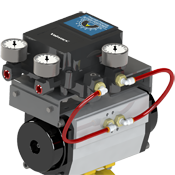
Positioners: Positioners, mounted and plumbed directly to the actuator, allow for throttling of the valve. There are two types of positioners. One is controlled by a 4-20mA electrical signal and the other by a 3-15 PSI pilot air signal. When the actuator is attached to a valve, flow can be adjusted anywhere between 0-100%.
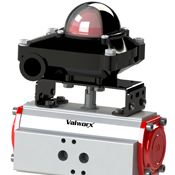
Limit Switches: Valve limit switches provide electrical and visual confirmation of the valve position. The limit switch box mounts to the top of the actuator.

Declutchable Gear Operators: Declutchable gear operators allow for manual operation of pneumatically actuated valves. The valve is decoupled from the actuator via a lever enabling the valve to be operated by the integral handwheel.
Speed Controllers: Speed controls meter the input and venting air to open/close the valve at speeds slower than normal actuation.
Mufflers: Mufflers are fastened to the vent ports and reduce noise by diffusing the venting air. Some also allow throttling of the venting air to control closing speed, although this is not as precise as speed controllers.
Pneumatically actuated valve applications are typically the technology of choice anywhere compressed air is readily available. Since they can be fitted to virtually any direct-mount quarter turn valve, they offer tremendous versatility. Given their relatively simple and rugged design, quality pneumatic actuators are also durable and reliable.

